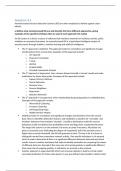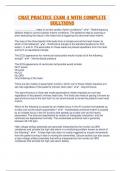MANAGING PEOPLE: PSYCHOLOGICAL FOUNDATION
Lecture 1 : introduction & motivation
Topics that will be discussed:
- Attitudes
- Motivation
- Culture
- Motivation
- Power
- Etc.
Core : functioning and wellbeing of people
Organizational behavior = interdisciplinary field dedicated to understanding people at work
Human resource management = the policies, practices and systems that influence
employees’ attitudes, behaviors, and performance.
How things are connected :
Course outline :
- Human factor in organizations
- Theories, relay on scientific evidence
MOTIVATION
Learning objectives :
- Be familiar with the concept motivation and with several traditional motivation theories
- Have basic understanding of the role of incentives in motivating employees
- Recognized several contemporary theories on motivation and be able to distinguish
their core differences
Why study motivation? → Relevant for our behavior, Performance management, Motivation
is crucial for all management subfields
Motivating/joyable job > wellpaid job
Jobs can be designing in a motivating way
Motivation = describes the psychological processes that underlie direction, intensity, and
persistence of behavior.
… = a set of energetic forces that originate within and outside an employee that initiates
work-related effort and determines its direction, intensity, and persistence.
,Early theories on motivation
Motivation theories :
Maslow’s hierarchy of needs
- Self-actualization
- Self-esteem
- Love and belonging
- Safety and security
- Psychological needs
>cultural issue → the importance of needs differ across cultures
ALDERFER’S ERG THEORY
Extension of Maslow’s theory → Existence, Relatedness, and Growth needs
Multiple needs can be activated simultaneously and change in prominence
>mixed empirical support
MCCLELLAND’S NEED THEORY
Every person has one of three main driving motivator : Achievement, Affiliation
(verbondenheid), and Power
>Popular lay theory based on value of extrinsic rewards
HERZBERG’S MOTIVATION-HYGIENE THEORY
Employee satisfaction has two dimensions: “hygiene” and “motivation”.
Hygiene : such as salary and supervision, decrease employees' dissatisfaction with the work
environment.
Motivators : such as recognition and achievement, make workers more productive, creative
and committed.
>Empirical support questionable; Two-factor aspect not as clear as portrayed
Equity theory (ADAMS)
Justice as a motive
Equity compares how well you are doing compared to how well others are doing in similar
jobs.. Instead of focusing just on what you put in and get out, equity theory also considers the
comparison of your input-output ratio to those of others
Important factor: fairness (cf. Organizational Justice Theory), sense of justice goes both
ways
,Self-determination theory (RYAN & DECI)
Interplay between intrinsic and extrinsic motivational factors
-three basic human needs :
Autonomy = the feeling one has choice and willingly endorsing one’s behavior
Competence/mastery = the experience of mastery and being effective in one’s activity
Relatedness = the need to feel connected and belonginess with others
Fulfilment of needs → wellbeing, engagement → intrinsic motivation
volition = wil
>Often used as foundation for job design theories (e.g., JD-R)
>Strong empirical support for validity and usefulness of the theory: When needs are met,
people perform better, are healthier, more engaged, and more committed (among other
outcomes)
- Implications for organizations: design jobs in such a way that autonomy, mastery, and
connectedness are promoted (e.g., allow space to self-manage, provide feedback
and support)
Context-based theories on motivation:
Hackman & Oldham (1980) : job design is the organization of a job’s element
Job characteristics model :
Job demand-resources theory (Demerouti et al., 2001; Bakker & Demerouti, 2014)
‘job resources are those physical, psychological, social or organizational aspects of the job
that are either functional in achieving work goals, reducing job demands, or stimulating
personal growth, learning and development’ like : autonomy, social support, opportunities for
development.’
‘ ‘’ ‘’ … that require sustained physical and/or psychological (cognitive and emotional) effort
and are therefore associated with certain physical and/or psychological costs’ like work
pressure, emotional workload, conflict’
, >JD-R model & SDT : job resources fulfil basic human needs of autonomy, competence, and
relatedness
Demand is not always negative : as long as they are manageable and buffered by sufficient
resources.
Find balance between : challenge demands vs. hindrance (belemmerende) demands
→to prevent bore out or burnouts
Conclusion : it’s important to understand individuals’ motivation in team systems and the
larger context
PROCESS-BASED THEORIES ON MOTIVATION
Expectancy theory (Vroom)
= the employee must believe the task is achievable, in order for them to put the effort into it.
1) Expectancy
Will maximum effort lead to postive performance appraisal (waardering)?
2) Instrumentality
Will good performance appriasal lead to fitting award?
3) Valence
Will the reward to fulfillment of goals
GOAL SETTING THEORY (LOCKE)
Attention
Effort
Persistence
Development of
goal-attainment
Influence on task
performance
SO …. Goal → behavioral intention → behavior
>people are generally motivated by challenging goals
Lecture 1 : introduction & motivation
Topics that will be discussed:
- Attitudes
- Motivation
- Culture
- Motivation
- Power
- Etc.
Core : functioning and wellbeing of people
Organizational behavior = interdisciplinary field dedicated to understanding people at work
Human resource management = the policies, practices and systems that influence
employees’ attitudes, behaviors, and performance.
How things are connected :
Course outline :
- Human factor in organizations
- Theories, relay on scientific evidence
MOTIVATION
Learning objectives :
- Be familiar with the concept motivation and with several traditional motivation theories
- Have basic understanding of the role of incentives in motivating employees
- Recognized several contemporary theories on motivation and be able to distinguish
their core differences
Why study motivation? → Relevant for our behavior, Performance management, Motivation
is crucial for all management subfields
Motivating/joyable job > wellpaid job
Jobs can be designing in a motivating way
Motivation = describes the psychological processes that underlie direction, intensity, and
persistence of behavior.
… = a set of energetic forces that originate within and outside an employee that initiates
work-related effort and determines its direction, intensity, and persistence.
,Early theories on motivation
Motivation theories :
Maslow’s hierarchy of needs
- Self-actualization
- Self-esteem
- Love and belonging
- Safety and security
- Psychological needs
>cultural issue → the importance of needs differ across cultures
ALDERFER’S ERG THEORY
Extension of Maslow’s theory → Existence, Relatedness, and Growth needs
Multiple needs can be activated simultaneously and change in prominence
>mixed empirical support
MCCLELLAND’S NEED THEORY
Every person has one of three main driving motivator : Achievement, Affiliation
(verbondenheid), and Power
>Popular lay theory based on value of extrinsic rewards
HERZBERG’S MOTIVATION-HYGIENE THEORY
Employee satisfaction has two dimensions: “hygiene” and “motivation”.
Hygiene : such as salary and supervision, decrease employees' dissatisfaction with the work
environment.
Motivators : such as recognition and achievement, make workers more productive, creative
and committed.
>Empirical support questionable; Two-factor aspect not as clear as portrayed
Equity theory (ADAMS)
Justice as a motive
Equity compares how well you are doing compared to how well others are doing in similar
jobs.. Instead of focusing just on what you put in and get out, equity theory also considers the
comparison of your input-output ratio to those of others
Important factor: fairness (cf. Organizational Justice Theory), sense of justice goes both
ways
,Self-determination theory (RYAN & DECI)
Interplay between intrinsic and extrinsic motivational factors
-three basic human needs :
Autonomy = the feeling one has choice and willingly endorsing one’s behavior
Competence/mastery = the experience of mastery and being effective in one’s activity
Relatedness = the need to feel connected and belonginess with others
Fulfilment of needs → wellbeing, engagement → intrinsic motivation
volition = wil
>Often used as foundation for job design theories (e.g., JD-R)
>Strong empirical support for validity and usefulness of the theory: When needs are met,
people perform better, are healthier, more engaged, and more committed (among other
outcomes)
- Implications for organizations: design jobs in such a way that autonomy, mastery, and
connectedness are promoted (e.g., allow space to self-manage, provide feedback
and support)
Context-based theories on motivation:
Hackman & Oldham (1980) : job design is the organization of a job’s element
Job characteristics model :
Job demand-resources theory (Demerouti et al., 2001; Bakker & Demerouti, 2014)
‘job resources are those physical, psychological, social or organizational aspects of the job
that are either functional in achieving work goals, reducing job demands, or stimulating
personal growth, learning and development’ like : autonomy, social support, opportunities for
development.’
‘ ‘’ ‘’ … that require sustained physical and/or psychological (cognitive and emotional) effort
and are therefore associated with certain physical and/or psychological costs’ like work
pressure, emotional workload, conflict’
, >JD-R model & SDT : job resources fulfil basic human needs of autonomy, competence, and
relatedness
Demand is not always negative : as long as they are manageable and buffered by sufficient
resources.
Find balance between : challenge demands vs. hindrance (belemmerende) demands
→to prevent bore out or burnouts
Conclusion : it’s important to understand individuals’ motivation in team systems and the
larger context
PROCESS-BASED THEORIES ON MOTIVATION
Expectancy theory (Vroom)
= the employee must believe the task is achievable, in order for them to put the effort into it.
1) Expectancy
Will maximum effort lead to postive performance appraisal (waardering)?
2) Instrumentality
Will good performance appriasal lead to fitting award?
3) Valence
Will the reward to fulfillment of goals
GOAL SETTING THEORY (LOCKE)
Attention
Effort
Persistence
Development of
goal-attainment
Influence on task
performance
SO …. Goal → behavioral intention → behavior
>people are generally motivated by challenging goals



